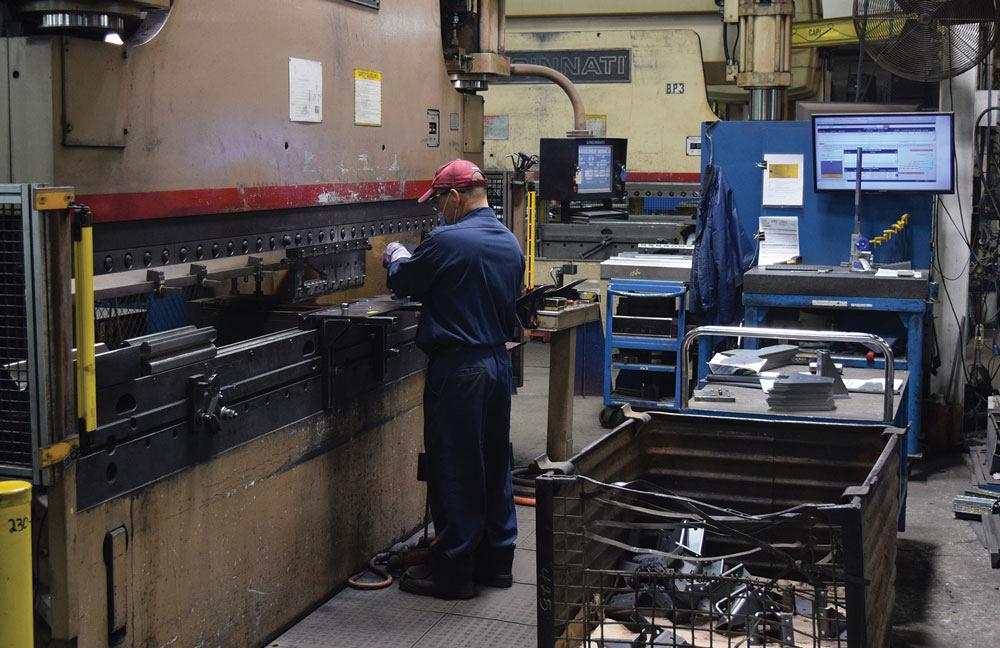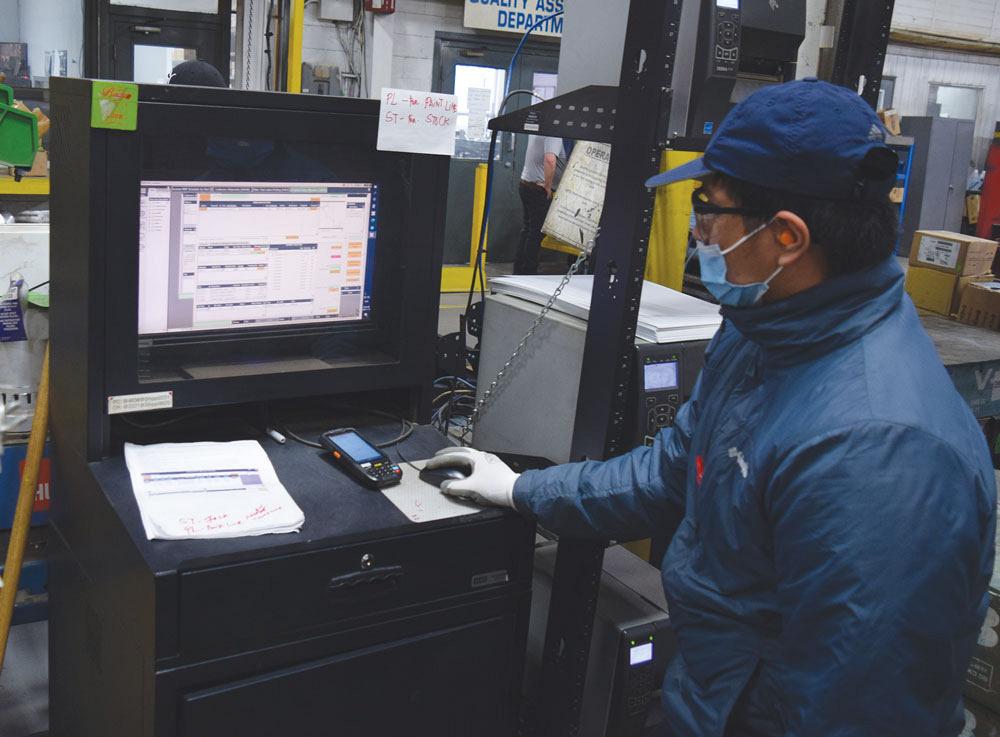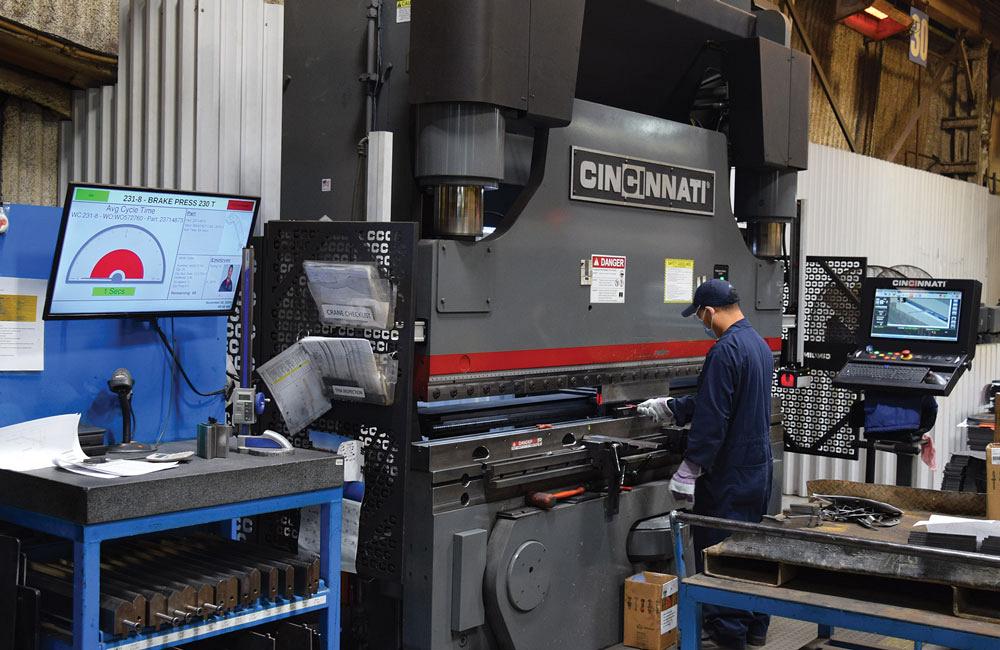Editor
- FMA
- The Fabricator
- FABTECH
- Canadian Metalworking
Ramping up efficiencies at Mancor
Vehicle part manufacturer gains from close partnership with sister company and ERP developer OnRamp
- By Rob Colman
- February 17, 2021
- Article
- Fabricating

This rivet machine uses 40 tons of force to rivet the part. It also uses sensors to ensure that the part is loaded correctly before any rivets can be made. Mancor uses various tools in its shop to ensure part accuracy, many of which can be accessed through its ERP system on the shop floor.
The development of any technology requires not only research, but also some kind of lab that allows you to determine if what you’ve designed is going to work in real life. This can be a challenge when your ideal lab is a factory floor. Introducing any new technology can be disruptive. When that technology is your enterprise resource planning (ERP) software, that can bog down all of your operations if managed poorly.
Art Church, founder of ERP software developer OnRamp Solutions, Oakville, Ont., was lucky in that when he was developing his software, he also served as CEO of Mancor Industries. Mancor is a manufacturer of metal components and subassemblies for vehicle manufacturers such as Mack Trucks and its parent company Volvo. Church remains the chairman of Mancor, and the shop still serves as the place where ideas for OnRamp are suggested and tested. It’s a unique arrangement and continues to benefit both companies.
ERP Learning
Church has been involved in using ERP systems for around 45 years.
“I worked at forestry machinery manufacturer Timberjack after graduating from Waterloo in mechanical engineering,” he said. “We installed an ERP system there and had some pretty good success with it. We put a lot of add-ons into the system, but that wasn’t considered a deficiency at the time because the software was so new.”
When Church later moved on to Champion Road Machinery, a manufacturer of road graders, he worked with another ERP system that required a lot of add-ons to function effectively for a producer of heavy machinery. When that company was purchased by Volvo, Church left with the idea that he would design his own ERP system for industry – something that truly served the needs of fabricators serving the industries he had been working with.
However, when the owners of Mancor approached him to invest in their company and take an active management role, he found the offer appealing.
“The partners made a deal with me that if I was to join them, I could develop the software for the company’s ERP system and run Mancor as CEO,” he said. “It gave me the chance to do everything I wanted to do. But when I first arrived, we had a system that was homegrown and really wasn’t very good. I played around with a lot of add-ons to that system and decided it wasn’t worth continuing that way, so we bought an off-the-shelf product to replace what we had. That didn’t work at all, and it was my fault for not seeing through it. We installed it and then had to develop all kinds of add-ons again. For instance, the shipping part of the system was so obtuse and complicated we would have trucks waiting for 1.5 hours before we could get all the paperwork to them. We had to develop our own shipping app just to solve these problems.”
Church realized it was time to bite the bullet and design an ERP system from the ground up that would meet Mancor’s specific needs. But he also wanted to make sure it would suit the needs of similar fabricating companies. It was never his intention that this would be strictly an in-house answer to a common problem.
From the Floorboards Up

Mancor designs its shop for optimal work flow. Its older CO2 lasers, for instance, are set up so that the person responsible for the laser also manages a press brake directly behind the laser. Part flow is managed so that production on the laser and press brake are evenly matched. At the press brake, the operator has access to shop drawings via the ERP system in case he needs to check any dimensions on the part.
Half of what Church wanted to do with his new software had already been developed as add-ons, so for him it was a natural progression to create a complete software package.
“I developed a way of working on the software that allowed us to do a lot with very few people,” he said. “The other advantage, of course, was having a captive customer in Mancor.”
This doesn’t mean mistakes haven’t been made along the way; it’s just that the OnRamp team has been able to react swiftly to remedy the mistake with input from the Mancor team.
“For instance, we developed a detailed capacity planning module,” Church said. “I gave it to the plant manager, and he said he liked the old version better. That’s when we realized that our design didn’t use a spreadsheet the way the old one did. The thing about a spreadsheet is that it’s easy to see all your variables, all of the what-ifs – what if I add more people, overtime, increase efficiency, etc. A spreadsheet is wonderful for doing that. The system now automatically creates a spreadsheet from scratch every time you open it. So if you add a machine, it will adapt to that automatically. There is no work to do. It’s probably one of the key things in terms of being efficient, to know what your earned hours are. If you don’t plan your manpower right, you’re not going to be profitable. A lot of people plan manpower helter-skelter. That’s been a really good tool for us.”
The OnRamp ERP system has now been implemented in all six Mancor plants – two in Oakville and four in the U.S. Five years ago OnRamp brought on its first external client.
Making It Work for Fab
Mancor’s needs dictated OnRamp’s development. Although one might think that would narrow the software’s utility to other companies, Mancor typifies the variety of orders a lot of fab shops have to contend with, even if the number of discrete customers may be lower.
Each Mancor plant has between three and seven customers. “We basically choose a few customers and serve as a significant supplier to them,” said Church. “We have always targeted mid-volume industries such as trucking and heavy construction. We don’t try to do high-volume automotive or low-volume custom. However, we do do short-run parts for the customers we serve to ensure we give them the best service. So some part numbers may amount to only 20 pieces a year, whereas others could amount to 30,000 pieces a year.” The Royal Windsor Drive, Oakville, shop makes 1,600 part and ships about 270 SKUs per day.
“If you can’t do those small volumes efficiently, you’ll get eaten alive,” said Church. The software helps with that, but software isn’t going to solve all your problems. If you have a bad system, though, it just makes things harder.”
What software can do, however, is simplify potentially challenging work flow and accounting issues. Church and the OnRamp team have focused on a few that are quite specific to fab shops.

About 75 per cent of all welding at Mancor is performed with automated weld cells. One of the newest cells is arranged to be operated by a non-welder. A monitor at the machine connected to the company ERP system lets the operator know what parts need to be loaded into the machine. The fixture is designed such that everything that needs to be loaded on it can be loaded only one way. Sensors in the machine indicate if any parts are missing. If they are, the machine won’t run the part.
The first of those issues was the finite capacity scheduling mentioned earlier. The system takes into account the capabilities (and limitations) of the shop floor machinery and staffing levels to determine how much work can be produced in a day.
“That capacity scheduling helps us smooth out our lumpy demand,” said Church. “I’ve worked with systems that didn’t have this capability and created chaos on the shop floor. The system just scheduled parts in the order we needed them. But we had an assembly line where some parts had to flow through our weld cells and our software wasn’t equipped to recognize that.”
The second issue was accounting for sheet steel use. Shops buy steel in pounds but use square feet. The sheet might arrive slightly thicker sometimes, but that weight difference won’t allow you to make any more parts. This makes planning and cycle counting potentially difficult.
“What we’ve done with the software is create a factor that indicates how many square feet represents a pound, so while we calculate our needs in square feet, the program translates that into pounds for ordering purposes.”
Laser nest management is another issue that can be difficult to transfer from nesting software to a central ERP system. At Mancor all nesting is performed overnight, and the nests that have been created then get transferred to the OnRamp system to be parcelled out to the lasers in the shop. The nests are displayed on the lasers at which they will be cut. Two laser cutting machines are managed by one team member.
“If the schedule of a nest changes, that change is made in the software and the schedule is updated on the operator’s screen,” said Church. “No one has to walk out onto the floor to inform the operator of any change because it’s made right on the screen for the operator.”
Another challenge is subcontracted work.
“Say you machine or make a part but then have to send it out for paint or electroplating,” said Church. “When it returns to your shop, it may require some cleanup work. Many systems aren’t designed to account for this. So we have a section to account for shipping a subcontract, receiving it, purchasing, and costing. It seems like such a small issue but becomes a big concern in work flow for most systems.”
The financial system in OnRamp is developed on a model that generates financials weekly for Mancor.
“We probably have 50 per cent of the financial staff that most companies need because when you are able to generate reports that often, it means a great deal of what you are doing has been automated,” said Church. “At Mancor, I have consolidated financial results Monday afternoon every week for the entire company.”

When a bar code being scanned on a box of parts ready to be shipped, all the labels they are going to need to verify the parts will be printed out. There are three verification stages in the shipping department, all involving scanning technology.
Seeing It Work
Church mentioned that without buy-in from the shop floor and champions in each department, the value of an ERP system doesn’t come to much. Of course, the relationship between Mancor and OnRamp makes this more likely to succeed. Still, it’s interesting to hear how departments have explained to OnRamp what they need and have made it work.
“Shipping, for instance, helped design the system they use,” said Jennifer Johnson, materials manager at Mancor. “They worked very closely for months to make that work. It used to be a purely visual check, verifying that the number on a part matched an order number. Now that is all verified using a scanner. And with this system, if the quantity, part number, or customer ID is incorrect, the system will notify you. On top of that, if anything in a truck hasn’t been scanned, a notification will go out and a check of that shipment will be made. Since we introduced the system last February, there hasn’t been one shipping error.”
As materials manager, Johnson is automatically notified of any scrap parts so that she can add that scrap to her material order by the end of the day.
“Information is always right there for you,” said Johnson. “If you’re not at your desk and you need to know the progress of a certain department, you can have automated emails sent to you with that information.”
The shop floor visibility is key for making many supervisors’ jobs simpler so that they can add value elsewhere.
“It gives me the ability to find out anything about what we’re manufacturing in real time,” said Aubrey Gaudaur, production supervisor, welding. “I can literally sit at my desk and see what my team has to deliver today and the status of all parts in their routings from raw steel through paint and shipping. We used to have to chase that information on the floor.
“It makes us a lot more efficient,” he continued. “Time management is very important. This gives me the ability to use my time more efficiently. It gives me more time to give to my employees on the floor, more time to do projects, more time to look at where I can make improvements.”
You can tell that for Church it’s just exciting to be able to come up with new ways to make life simpler for the team. During my visit he was prototyping a push-button panel below a monitor at a workstation to simplify accessing information on the screen.
“Guys working in the shop get their hands dirty, and having to use a keyboard can get messy,” said Church. “We’re trying out this panel where they can access different information by hitting different buttons. If it works properly, it will be faster and more convenient.”

Display screens (seen to the left of the press brake here) can display any information that the operator or manager wants it to, such as work instructions, part drawings or, in this case, stats on the average cycle time of a part bending operation.
Greater efficiency is, of course, a win for everyone.
Editor Robert Colman can be reached at rcolman@canadianfabweld.com.
Mancor Industries, www.mancor.com
OnRamp Solutions, www.onramp-solutions.com
About the Author

Rob Colman
1154 Warden Avenue
Toronto, M1R 0A1 Canada
905-235-0471
Robert Colman has worked as a writer and editor for more than 25 years, covering the needs of a variety of trades. He has been dedicated to the metalworking industry for the past 13 years, serving as editor for Metalworking Production & Purchasing (MP&P) and, since January 2016, the editor of Canadian Fabricating & Welding. He graduated with a B.A. degree from McGill University and a Master’s degree from UBC.
subscribe now


Keep up to date with the latest news, events, and technology for all things metal from our pair of monthly magazines written specifically for Canadian manufacturers!
Start Your Free Subscription- Trending Articles
Aluminum MIG welding wire upgraded with a proprietary and patented surface treatment technology

Achieving success with mechanized plasma cutting

Hypertherm Associates partners with Rapyuta Robotics

Gema welcomes controller

Brushless copper tubing cutter adjusts to ODs up to 2-1/8 in.

- Industry Events
MME Winnipeg
- April 30, 2024
- Winnipeg, ON Canada
CTMA Economic Uncertainty: Helping You Navigate Windsor Seminar
- April 30, 2024
- Windsor, ON Canada
CTMA Economic Uncertainty: Helping You Navigate Kitchener Seminar
- May 2, 2024
- Kitchener, ON Canada
Automate 2024
- May 6 - 9, 2024
- Chicago, IL
ANCA Open House
- May 7 - 8, 2024
- Wixom, MI















